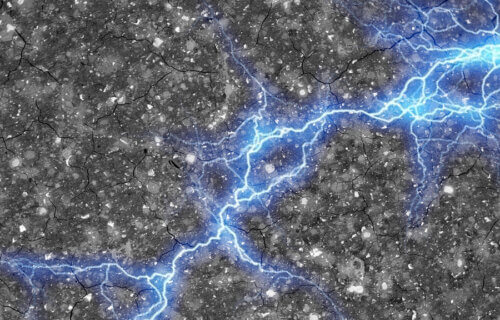CAMBRIDGE, Mass. — Massachusetts Institute of Technology engineers have created an energy-storing supercapacitor just using cement, carbon black, and water. This new invention could potentially stabilize energy networks, allowing them to consistently use renewable energy sources like solar and wind despite their unpredictable supply rates.
Researchers discovered that by blending cement and carbon black — ancient and abundant materials — with water, they could create a supercapacitor, an alternative to conventional batteries, capable of storing electrical energy. MIT scientists believe that such a supercapacitor could be integrated into a house’s concrete foundation, storing a day’s worth of energy without increasing the foundation’s cost while maintaining its structural integrity. There’s even a potential for a concrete roadway that wirelessly charges electric vehicles as they drive over it.
Capacitors are basic devices made of two electrically conductive plates submerged in a liquid, separated by a barrier. When these plates are charged, they can store that charge for extended periods and release it rapidly when required. Supercapacitors are a kind of capacitor that can hold significantly larger charges.
The groundbreaking aspect of the MIT team’s supercapacitors lies in their method. They created a cement-based material filled with conductive pathways, resulting from the addition of carbon black – a highly conductive substance – to a mixture of cement powder and water. This process creates an intricate, tree-like internal structure with a vast surface area, crucial for storing energy.

“The material is fascinating, because you have the most-used manmade material in the world, cement, that is combined with carbon black, that is a well-known historical material — the Dead Sea Scrolls were written with it,” says study co-author Admir Masic, a professor at MIT, in a university release. “You have these at least two-millennia-old materials that when you combine them in a specific manner you come up with a conductive nanocomposite, and that’s when things get really interesting.”
The benefits of these concrete supercapacitors are manifold. Primarily, they could significantly aid the transition to renewable energy. Study co-author Franz-Josef Ulm, a professor at MIT, underscored the urgency of finding affordable storage solutions, especially given the inconsistencies of renewable energy production. With the raw materials being cheap and easily available, this innovation appears promising.
“There is a huge need for big energy storage,” says Ulm. “That’s where our technology is extremely promising, because cement is ubiquitous.”
The team calculated that a 45-cubic-meter block of their specialized concrete could store around 10 kilowatt-hours of energy, roughly the daily electricity usage for an average home. Given that the concrete maintains its strength, a house could store energy from solar panels or wind turbines and utilize it on demand.
The technology’s versatility also stands out. Researchers emphasized the adaptability of the system, explaining that it can be adjusted depending on the desired application.
“You can go from 1-millimeter-thick electrodes to 1-meter-thick electrodes, and by doing so basically you can scale the energy storage capacity from lighting an LED for a few seconds, to powering a whole house,” says Ulm, adding that this innovation is “a new way of looking toward the future of concrete as part of the energy transition.”
The study is published in the journal PNAS.

